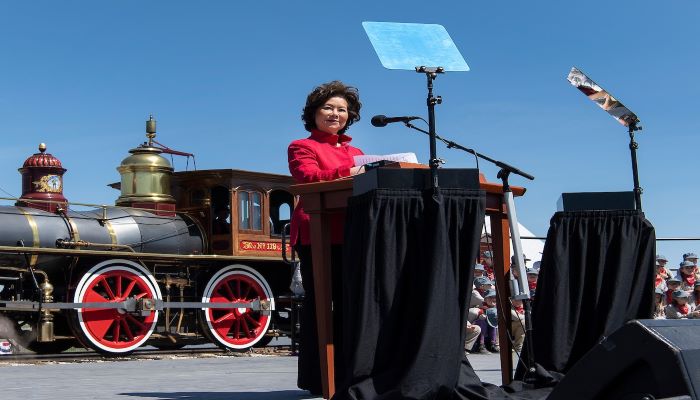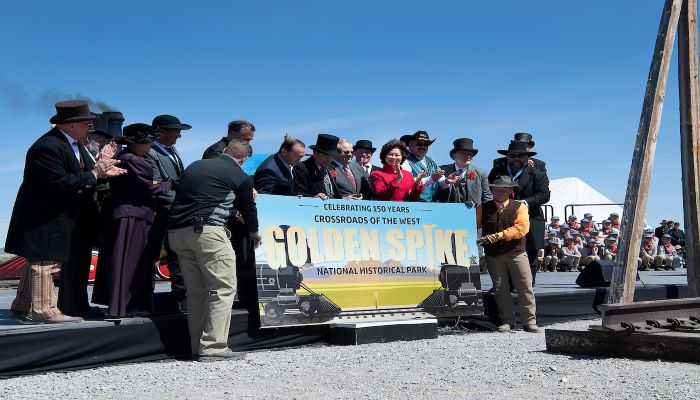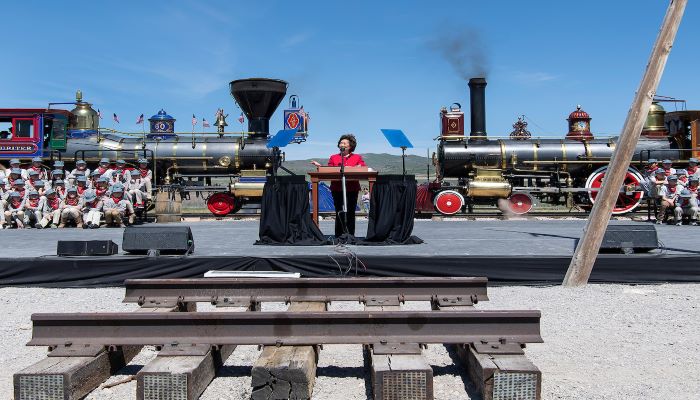Promontory Summit, Utah – At the 150th Anniversary of the Golden Spike ceremony marking the completion of the transcontinental railroad, one of the greatest infrastructure projects in American history, U.S. Secretary of Transportation Elaine L. Chao gave a keynote address acknowledging and honoring the sacrifices and contributions of the more than 12,000 Chinese laborers whose courage, dedication and sacrifices made this historic achievement possible.

Finished a few years after the Civil War, the transcontinental railroad transformed America – connecting people, territories, and states from coast to coast.
“At this momentous and historic event today, we are paying a very special and long overdue tribute to the approximately 12,000 or more Chinese laborers who built the transcontinental railroad. The Chinese laborers’ contributions helped transform America by laying the foundation for the economic vibrancy of our nation for generations. They laid the tracks and built the tunnels that cut through the rugged Sierra Nevada mountains in conditions that were merciless, dangerous and harsh. The Chinese workers suffered greatly and an estimated 500-1,000 lost their lives. Their achievement was even more impressive given that these Chinese workers did not have the opportunity to bring their families with them, or to become American citizens,” said U. S. Secretary of Transportation Elaine L. Chao.
As the first Asian Pacific American woman ever appointed to the President’s cabinet and the first American of Chinese ancestry to serve as U.S. Secretary of Transportation, Secretary Elaine L. Chao is uniquely qualified to commemorate the historic contributions that Chinese laborers made to the building of the transcontinental railroad.

During this anniversary week, the Secretary also attended several community events such as the Chinese Railroad Workers Descendants Association; the Chinese American Cultural Committee for Golden Spike; and, the Utah Chinese Golden Spike Celebration Committee to participate and ensure that the contributions of the Chinese workers were properly and fully recognized in Utah. In 2017, the Secretary had also visited the Chinese Transcontinental Railroad Workers Photographic Exhibition in New York City’s Chinatown.
In addition to U. S. Secretary of Transportation Elaine L. Chao, other distinguished guests at the 150thanniversary celebration included U.S. Secretary of the Interior David Bernhardt; Utah Governor Gary Herbert; Utah Lieutenant Governor Spencer J. Cox; U.S. Senator Mitt Romney (R-Utah); U.S. Senator Mike Lee (R-Utah); former U.S. Senator Orrin Hatch (R-Utah); U.S. Congressman Rob Bishop; and many organizations representing the Chinese immigrants who worked on the transcontinental railroad including the Chinese Railroad Workers Descendants Association; the Chinese American Cultural Committee for Golden Spike; and the Utah Chinese Golden Spike Celebration Committee.
Promontory Summit in Utah was the site of the first Golden Spike ceremony 150 years ago, which announced the completion of America’s first Transcontinental Railroad. It was a tremendous feat of engineering, innovation and sheer manpower involving thousands of immigrants. Building from the East, the Union Pacific hired many Irish immigrants to lay track across the Great Plains.

Building from the West, the Central Pacific Railroad hired 15,000 workers, approximately 12,000 or more of whom were Chinese laborers. The Chinese workers blasted and chiseled their way through the rugged Sierra Nevada mountains. Using manual hammer drills, pickaxes and explosives, they dug 15 tunnels through hard granite. Snow fell so deep in the mountains that they had to build roofs over 37 miles of track so supply trains could make it through. The conditions were merciless, dangerous and harsh. An estimated 500-1,000 Chinese workers lost their lives. Their contributions are even more because many Chinese workers could not bring their families with them nor obtain American citizenship.
Within three years of the completion of the Transcontinental Railroad, trains could travel from New York City to San Francisco in just one week. Prior to the completion of the railroad, travelers spent up to six arduous months traveling by ship or covered wagon, often enduring great dangers at great cost.
The ability to move people and goods across the continent at much shorter times and lower costs led to rapid economic growth. The benefits were not only felt in the cities on the coasts, but also in communities in the interior, which gained access to new markets. Within ten years of completion, the intercontinental railways were shipping $50 million of freight from coast to coast each year.
This great history, which helped to transform America, was made possible by the dedication, determination, hard work and sacrifices of the Chinese laborers who left their homeland in search of better opportunities. The Chinese laborers risked everything to make the transcontinental railroad a reality.
The Golden Spike was the 17.6 karat final spike driven in to join the Central Pacific and Union Pacific railroads, creating the first Transcontinental Railroad across the United States. This connected the eastern U.S. rail network with the San Francisco Bay via Council Bluffs, Iowa, and Omaha, Nebraska.



















